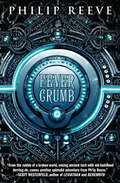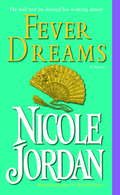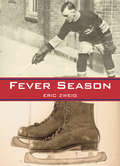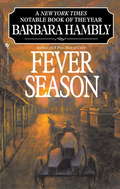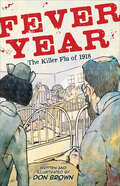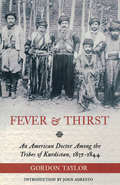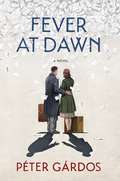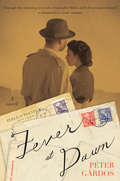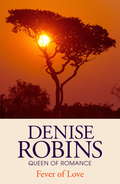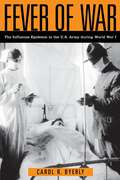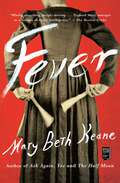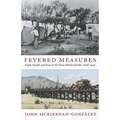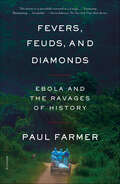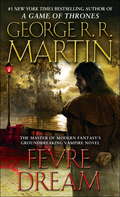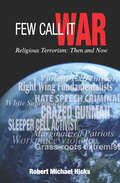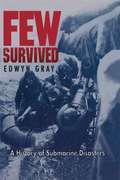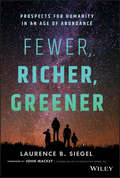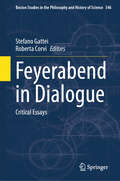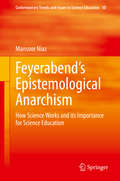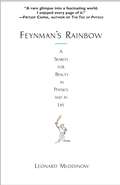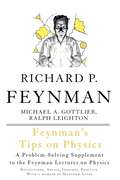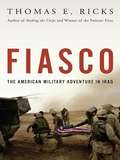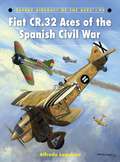- Table View
- List View
Fever Crumb (Fever Crumb Triology #1)
by Philip Reeve“From the rubble of a broken world, mixing ancient tech with old-fashioned derring-do, comes another splendid adventure” by the author of Mortal Engines (Scott Westerfeld, New York Times–bestselling author).A School Library Journal Best Book of the YearA Kirkus Reviews Best Book for TeensAn ALA Best Fiction for Young AdultsAn ALA Notable Children’s BookThere’s a great secret lurking in Fever’s past. When Fever Crumb begins to assist archeologist Kit Solent on a top-secret project involving a long-dead Scriven overlord, she is plagued by memories that are not her own. And Kit seems to have a particular interest in finding out what they are. All Fever knows is what she’s been told: that she is an orphan. Is Fever a Scriven? Whose memories does Fever hold? And why are there people chasing her?Haunting, arresting, and astonishingly original, Fever Crumb will delight readers at every fast-paced, breathless turn.“[An] exciting steampunk adventure . . . Beautifully written, grippingly paced, and filled with eccentric characters and bizarre inventions.” —Publishers Weekly (starred review)“Rejoice! Reeve returns to the vivid, violent, steampunky world of his Hungry Cities Chronicles . . . a finely wrought coming-of-age story.” —Kirkus Reviews“Reeve’s captivating flights of imagination play as vital a role in the story as his endearing heroine, hissworthy villains, and nifty array of supporting characters.” —Booklist (starred review)“Reeve is not just an excellent writer, but a creator with a wildly imaginative mind. The future London setting of this story is well imagined and feels like a place Charles Dickens might have described had he been a science-fiction writer . . . A must for any fantasy collection.” —School Library Journal
Fever Dreams
by Nicole JordanOnce again Nicole Jordan thrills and enchants with this fabulously seductive Regency romance, the next installment in the Paradise series.She is the woman of his dreams . . . and he will pay any price to possess her.From the moment he met the lovely Lady Eve, soldier of fortune Alex Ryder set his sights on winning the spirited beauty. But fate intervened, making Eve another man's wife then a widow. Now, despite Eve's ardent vow never to marry again, Ryder aims to use every seductive weapon in his arsenal to woo her.A renowned matchmaker for the ton, Eve defies Ryder's wicked allure but cannot resist his challenge to find him a suitable bride-never dreaming that she is the only woman he will ever desire for his bride, or that his breathtaking sensuality will awaken her to soul-searing passion.But as their delicious mating dance begins, an assailant threatens Eve's life. Now Ryder must protect Eve while striving to convince his beloved that he alone is her perfect match in the tantalizing game of love. From the Paperback edition.
Fever Season
by Eric ZweigEric Zweig is a managing editor with Dan Diamond & Associates, consulting publishers to the National Hockey League. He has written about sports and sports history for many major publications, including the Toronto Star and the Globe and Mail His non-fiction sports books for young people include Star Power: The Legend and Lore of Cyclone Taylor and Crazy Canucks. He lives in Owen Sound, Ontario.
Fever Season (Benjamin January #2)
by Barbara HamblyBenjamin January made his debut in bestselling author Barbara Hambly'sA Free Man of Color,a haunting mélange of history and mystery. Now he returns in another novel of greed, madness, and murder amid the dark shadows and dazzling society of old New Orleans. . . The summer of 1833 has been one of brazen heat and brutal pestilence, as the city is stalked by Bronze John--the popular name for the deadly cholera epidemic that tests the healing skills of doctor and voodoo alike. Benjamin January's Paris medical training keeps him all night long with the dying at Charity Hospital. Then his work as a music teacher takes him out again into the fetid, empty midday streets. Empty except for Cora Chouteau, a dark-skinned plantation waif come to town in search of her lover, sold in slavery to one of its prominent families. Though January's certain she's a runaway, he agrees to try to pass a message to the man she seeks. Soon, however, he learns that Cora is accused of murdering her lecherous master, Otis Redfern, and poisoning his wife almost to death. And of stealing five thousand dollars and a pearl necklace. Yet it seems that Emily Redfern herself, iron-willed and socially ambitious, had cause to wish her profligate husband dead. And Cora, too--or so the girl insists. . . . Before Ben can unpick one story from the other, Cora disappears into the torrid night. And as storms rage in from the Gulf, he is swept into an inquiry that leads into a labyrinth of lives: from the vulgar American Emily Redfern to Madame Delphine Lalaurie, flawless jewel of Creole society, and from the wisdom of a voodoo queen to the learning of a lovely schoolmistress, Cora's only true friend. Risking both his life and his freedom, Ben pursues the truth through a lush and fevered world of opulent town houses, grim cemeteries, and raucous taverns. A gilded world of injustice, deceit, and calumny--and a half-glimpsed horror that far transcends the perils of. . . Fever Season. Barbara Hambly attended the University of California and spent a year at the University of Bordeaux, France, obtaining a master's degree in medieval history in 1975. She has worked as both a teacher and a technical editor, but her first love has always been history. Ms. Hambly lives in New Orleans and Los Angeles with two Pekingese, a cat, and another writer. She is at work on her next historical novel,Graveyard Dust.
Fever Year: The Killer Flu of 1918
by Don BrownFrom the Sibert Honor–winning creator behind The Unwanted and Drowned City comes one of the darkest episodes in American history: the Spanish Influenza epidemic of 1918. This nonfiction graphic novel explores the causes, effects, and lessons learned from a major epidemic in our past, and is the perfect tool for engaging readers of all ages, especially teens and tweens learning from home. New Year&’s Day, 1918. America has declared war on Germany and is gathering troops to fight. But there&’s something coming that is deadlier than any war. When people begin to fall ill, most Americans don&’t suspect influenza. The flu is known to be dangerous to the very old, young, or frail. But the Spanish flu is exceptionally violent. Soon, thousands of people succumb. Then tens of thousands . . . hundreds of thousands and more. Graves can&’t be dug quickly enough. What made the influenza of 1918 so exceptionally deadly—and what can modern science help us understand about this tragic episode in history? With a journalist&’s discerning eye for facts and an artist&’s instinct for true emotion, Sibert Honor recipient Don Brown sets out to answer these questions and more in Fever Year.
Fever and Thirst: An American Doctor Among the Tribes of Kurdistan, 1835-1844
by Gordon TaylorThe first Americans to work with the people of the Middle East were neither spies nor soldiers. They were, in fact, teachers, printers, and missionaries; and one was a country doctor from Utica, NY. In June of 1835 Asahel Grant, M.D. and his bride, Judith, sailed from Boston to heal the sick and save the world. Fever and Thirst tells the story of Asahel Grant: explorer, physician, author and the first American to become enmeshed in the struggles of northern Iraq.
Fever at Dawn
by Péter GárdosTwenty-five-year-old Holocaust survivor Miklós is being shipped from the Bergen-Belsen concentration camp to Gotland, Sweden, to receive treatment at the Larbro Hospital. Here he is sentenced to death again: he is diagnosed with tuberculosis and his doctors inform him that he has six months to live. But Miklós decides to wage war on his own fate: he writes 117 letters to 117 Hungarian girls, all of whom are being treated in the Swedish camps, with the aim of eventually choosing a wife from among them. Two hundred kilometres away, in another Swedish rehabilitation camp, nineteen-year-old Lili receives Miklós’s letter. Since she is bedridden for three weeks due to a serious kidney problem, out of boredom — and curiosity — she decides to write back. The slightly formal exchange of letters becomes increasingly intimate. When the two finally manage to meet, they fall in love and are determined to marry, despite the odds that are against them. Based on the original letters written by Miklós and Lili (ninety-six altogether), Fever at Dawn is a tale of passion, striving, and betrayal; true and false friendships; doubt and faith; and the redeeming power of love.
Fever at Dawn: A Novel
by Péter GárdosAfter World War II, two concentration camp survivors begin a battle for love in this heartwarming, historical novel based on a true story.It&’s 1945, and Miklós is looking for a wife. The fact that he has six months left to live doesn&’t discourage him—he isn&’t one to let small problems like that stand in the way, especially not after he&’s survived a concentration camp. Currently marooned in an all-male sanatorium in Sweden, and desperate to get out, he acquires the names of the 117 Hungarian women also recovering in Sweden and writes each of them a letter in his beautiful cursive hand. Luckily for him, Lili decides to write back…Drawn from the real-life letters of Péter Gárdos&’s parents, and reminiscent of the film Life Is Beautiful, Fever at Dawn is a vibrant, ribald, and unforgettable tale, showing the death-defying power of the human will to live and to love.&“Fever at Dawn has the sweetness of The Rosie Project and the pathos of The Fault in Our Stars…A book to fall in love with.&”—The Herald Sun&“At once heartrending and lighthearted, this romance covers enormous ground in love and war, joy and tragedy.&” — Shelf Awareness, starred review &“A riveting and high-spirited journey from the brink of death toward life, [Fever at Dawn] asserts the power of love.&”—Julie Orringer, author of The Invisible Bridge
Fever of Love
by Denise RobinsAn enthralling story from the 100-million-copybestselling Queen of Romance, first published in 1950 and now available ineBook for the first time.Verona meets Stephen in Paris as afellow student, he is the most brilliant young artist in London, and she loveshim madly. His portrait of her is magnificent, capturing her large, lustrouseyes and creamy skin. Though their love is true, Verona refuses to be Stephen'smistress and leaves him in order to marry a young army officer. She tries to behappy, but soon she finds herself longing for the bohemian life of her formerdays, and, when her husband is stationed in Egypt, begins to wonder what wouldhappen if, just by chance, she should run into Stephen again...
Fever of Love
by Denise RobinsAn enthralling story from the 100-million-copybestselling Queen of Romance, first published in 1950 and now available ineBook for the first time.Verona meets Stephen in Paris as afellow student, he is the most brilliant young artist in London, and she loveshim madly. His portrait of her is magnificent, capturing her large, lustrouseyes and creamy skin. Though their love is true, Verona refuses to be Stephen'smistress and leaves him in order to marry a young army officer. She tries to behappy, but soon she finds herself longing for the bohemian life of her formerdays, and, when her husband is stationed in Egypt, begins to wonder what wouldhappen if, just by chance, she should run into Stephen again...
Fever of War: The Influenza Epidemic in the U.S. Army during World War I
by Carol R ByerlyThe influenza epidemic of 1918 killed more people in one year than the Great War killed in four, sickening at least one quarter of the world's population. In Fever of War, Carol R. Byerly uncovers the startling impact of the 1918 influenza epidemic on the American army, its medical officers, and their profession, a story which has long been silenced. Through medical officers' memoirs and diaries, official reports, scientific articles, and other original sources, Byerly tells a grave tale about the limits of modern medicine and warfare.The tragedy begins with overly confident medical officers who, armed with new knowledge and technologies of modern medicine, had an inflated sense of their ability to control disease. The conditions of trench warfare on the Western Front soon outflanked medical knowledge by creating an environment where the influenza virus could mutate to a lethal strain. This new flu virus soon left medical officers’ confidence in tatters as thousands of soldiers and trainees died under their care. They also were unable to convince the War Department to reduce the crowding of troops aboard ships and in barracks which were providing ideal environments for the epidemic to thrive. After the war, and given their helplessness to control influenza, many medical officers and military leaders began to downplay the epidemic as a significant event for the U. S. army, in effect erasing this dramatic story from the American historical memory.
Fever: A Novel
by Mary Beth KeaneFrom the bestselling author of Ask Again, Yes, a novel about the woman known as &“Typhoid Mary,&” who becomes, &“in Keane&’s assured hands…a sympathetic, complex, and even inspiring character&” (O, The Oprah Magazine).Mary Beth Keane has written a spectacularly bold and intriguing novel about the woman known as &“Typhoid Mary,&” the first person in America identified as a healthy carrier of Typhoid Fever. On the eve of the twentieth century, Mary Mallon emigrated from Ireland at age fifteen to make her way in New York City. Brave, headstrong, and dreaming of being a cook, she fought to climb up from the lowest rung of the domestic-service ladder. Canny and enterprising, she worked her way to the kitchen, and discovered in herself the true talent of a chef. Sought after by New York aristocracy, and with an independence rare for a woman of the time, she seemed to have achieved the life she&’d aimed for when she arrived in Castle Garden. Then one determined &“medical engineer&” noticed that she left a trail of disease wherever she cooked, and identified her as an &“asymptomatic carrier&” of Typhoid Fever. With this seemingly preposterous theory, he made Mallon a hunted woman. The Department of Health sent Mallon to North Brother Island, where she was kept in isolation from 1907 to 1910, then released under the condition that she never work as a cook again. Yet for Mary—proud of her former status and passionate about cooking—the alternatives were abhorrent. She defied the edict. Bringing early-twentieth-century New York alive—the neighborhoods, the bars, the park carved out of upper Manhattan, the boat traffic, the mansions and sweatshops and emerging skyscrapers—Fever is an ambitious retelling of a forgotten life. In the imagination of Mary Beth Keane, Mary Mallon becomes a fiercely compelling, dramatic, vexing, sympathetic, uncompromising, and unforgettable heroine.
Fevered Lives: Tuberculosis in American Culture since 1870
by Katherine OttFevered Lives underscores the shifting meanings of consumption/tuberculosis in an extraordinarily readable cultural history.
Fevered Measures: Public Health and Race at the Texas-Mexico Border, 1848-1942
by John Mckiernan-GonzalezIn this book, the author examines public health campaigns along the Texas-Mexico border between 1848 and 1942 and reveals the changing medical and political frameworks U.S. health authorities used when facing the threat of epidemic disease. The medical borders created by these officials changed with each contagion and sometimes varied from the existing national borders. Federal officers sought to distinguish Mexican citizens from U.S. citizens, a process troubled by the deeply interconnected nature of border communities. The author uncovers forgotten or ignored cases in which Mexicans, Mexican Americans, African Americans, and other groups were subject to--and sometimes agents of--quarantines, inspections, detentions, and forced-treatment regimens. These cases illustrate the ways that medical encounters shaped border identities before and after the Mexican Revolution. The author also maintains that the threat of disease provided a venue to destabilize identity at the border, enacted processes of racialization, and re-legitimized the power of U.S. policymakers. He demonstrates how this complex history continues to shape and frame contemporary perceptions of the Latino body today.
Fevers, Feuds, and Diamonds: Ebola and the Ravages of History
by Paul Farmer“Paul Farmer brings his considerable intellect, empathy, and expertise to bear in this powerful and deeply researched account of the Ebola outbreak that struck West Africa in 2014. It is hard to imagine a more timely or important book.” —Bill and Melinda Gates"[The] history is as powerfully conveyed as it is tragic . . . Illuminating . . . Invaluable." —Steven Johnson, The New York Times Book ReviewIn 2014, Sierra Leone, Liberia, and Guinea suffered the worst epidemic of Ebola in history. The brutal virus spread rapidly through a clinical desert where basic health-care facilities were few and far between. Causing severe loss of life and economic disruption, the Ebola crisis was a major tragedy of modern medicine. But why did it happen, and what can we learn from it? Paul Farmer, the internationally renowned doctor and anthropologist, experienced the Ebola outbreak firsthand—Partners in Health, the organization he founded, was among the international responders. In Fevers, Feuds, and Diamonds, he offers the first substantive account of this frightening, fast-moving episode and its implications. In vibrant prose, Farmer tells the harrowing stories of Ebola victims while showing why the medical response was slow and insufficient. Rebutting misleading claims about the origins of Ebola and why it spread so rapidly, he traces West Africa’s chronic health failures back to centuries of exploitation and injustice. Under formal colonial rule, disease containment was a priority but care was not – and the region’s health care woes worsened, with devastating consequences that Farmer traces up to the present. This thorough and hopeful narrative is a definitive work of reportage, history, and advocacy, and a crucial intervention in public-health discussions around the world.
Fevre Dream: A Novel (Fantasy Masterworks Ser. #Vol. 13)
by George R. R. MartinWhen struggling riverboat captain Abner Marsh receives an offer of partnership from a wealthy aristocrat, he suspects something's amiss. But when he meets the hauntingly pale, steely-eyed Joshua York, he is certain. For York doesn't care that the icy winter of 1857 has wiped out all but one of Marsh's dilapidated fleet. Nor does he care that he won't earn back his investment in a decade. York has his own reasons for wanting to traverse the powerful Mississippi. And they are to be none of Marsh's concern--no matter how bizarre, arbitrary, or capricious his actions may prove. Marsh meant to turn down York's offer. It was too full of secrets that spelled danger. But the promise of both gold and a grand new boat that could make history crushed his resolve--coupled with the terrible force of York's mesmerizing gaze. Not until the maiden voyage of his new sidewheeler Fevre Dream would Marsh realize he had joined a mission both more sinister, and perhaps more noble, than his most fantastic nightmare...and mankind's most impossible dream. Here is the spellbinding tale of a vampire's quest to unite his race with humanity, of a garrulous riverman's dream of immortality, and of the undying legends of the steamboat era and a majestic, ancient river.From the Trade Paperback edition.
Few Call It War: Religious Terrorism: Then and Now
by Robert Michael Hicks&“A highly readable and well-documented account of the use and abuse of religion for violent political ends . . . This is a book well worth reading&” (Timothy J. Demy, ThD, PhD, coauthor of In the Name of God). Most Americans could not fathom how Islamic terrorists could bring down the World Trade Center or an army psychiatrist could turn on his own soldiers, taking their lives in the name of his religion. How could an ex-army veteran blow up a federal building, or a Jewish doctor gun down Muslims at worship? None of these incidents fit our conceptions of the benevolence of religion. More importantly, is there something inherent within religions that justifies the taking of human lives? In Few Call It War, Dr. Robert Hicks explores these questions and takes the blinders off illuminating the roots of religious violence, what religious terrorists have in common, and how they differ. As Hicks points out, all major religions have used violence and terrorist methodologies at some points in their histories. Few Call It War reveals how the teachings of religious founders and the sacred writings attributed to them provide rich soil from which contemporary religious clerics and ideologues gain converts. If one is interested in gaining an answer to the question, &“Of all the religions in the world, which are most prone to using violence?&” Few Call It War provides a well-reasoned answer that is well worth the read. &“A masterpiece in the study of religiously motivated terrorism. He has been fair in his critique of all religions, including movements within Judaism and even Christianity.&” —Robert L. Brennemann, PhD, professor, Intercultural Studies, North Central University
Few Survived: A History of Submarine Disasters
by Edwyn GrayA revised edition of an account of peacetime submarine disasters from 1774 to the present day, previously published in 1991. Examines the development of the submarine from experimental stages in the late 18th century to the present day, and provides details of all disasters ever reported.
Fewer, Richer, Greener: Prospects for Humanity in an Age of Abundance
by Laurence B. SiegelHow the world has become much better and why optimism is abundantly justified Why do so many people fear the future? Is their concern justified, or can we look forward to greater wealth and continued improvement in the way we live? Our world seems to be experiencing stagnant economic growth, climatic deterioration, dwindling natural resources, and an unsustainable level of population growth. The world is doomed, they argue, and there are just too many problems to overcome. But is this really the case? In Fewer, Richer, Greener, author Laurence B. Siegel reveals that the world has improved—and will continue to improve—in almost every dimension imaginable. This practical yet lighthearted book makes a convincing case for having gratitude for today’s world and optimism about the bountiful world of tomorrow. Life has actually improved tremendously. We live in the safest, most prosperous time in all human history. Whatever the metric—food, health, longevity, education, conflict—it is demonstrably true that right now is the best time to be alive. The recent, dramatic slowing in global population growth continues to spread prosperity from the developed to the developing world. Technology is helping billions of people rise above levels of mere subsistence. This technology of prosperity is cumulative and rapidly improving: we use it to solve problems in ways that would have be unimaginable only a few decades ago. An optimistic antidote for pessimism and fear, this book: Helps to restore and reinforce our faith in the future Documents and explains how global changes impact our present and influence our future Discusses the costs and unforeseen consequences of some of the changes occurring in the modern world Offers engaging narrative, accurate data and research, and an in-depth look at the best books on the topic by leading thinkers Traces the history of economic progress and explores its consequences for human life around the world Fewer, Richer, Greener: Prospects for Humanity in an Age of Abundance is a must-read for anyone who wishes to regain hope for the present and wants to build a better future.
Feyerabend in Dialogue: Critical Essays (Boston Studies in the Philosophy and History of Science #346)
by Stefano Gattei Roberta CorviThis book offers innovative historical scholarship on Feyerabend’s take on topics such as realism, empiricism, pluralism, materialism, and incommensurability. In addition to discussing certain debates in the philosophy of physics, it also considers the ways in which Feyerabend’s thought can contribute to contemporary debates in science and public policy. It does so by including questions about the nature of scientific methodology, the role of science in society, the public understanding of science, scientism, and the role of expertise in public policy. The chapters provide readers with a comprehensive overview of the topics that Feyerabend engaged with throughout his career, showing both the breadth and the depth of his thought. Though of great value to academics in philosophy of science, it is also accessible and appealing to non-academic audiences with a general interest in science.
Feyerabend’s Epistemological Anarchism: How Science Works and its Importance for Science Education (Contemporary Trends and Issues in Science Education #50)
by Mansoor NiazThis book argues that the traditional image of Feyerabend is erroneous and that, contrary to common belief, he was a great admirer of science. It shows how Feyerabend presented a vision of science that represented how science really works. Besides giving a theoretical framework based on Feyerabend´s philosophy of science, the book offers criteria that can help readers to evaluate and understand research reported in important international science education journals, with respect to Feyerabend’s epistemological anarchism. The book includes an evaluation of general chemistry and physics textbooks. Most science curricula and textbooks provide the following advice to students: Do not allow theories in contradiction with observations, and all scientific theories must be formulated inductively based on experimental facts. Feyerabend questioned this widely prevalent premise of science education in most parts of the world, and in contrast gave the following advice: Scientists can accept a hypothesis despite experimental evidence to the contrary and scientific theories are not always consistent with all the experimental data. No wonder Feyerabend became a controversial philosopher and was considered to be against rationalism and anti-science. Recent research in philosophy of science, however, has shown that most of Feyerabend´s philosophical ideas are in agreement with recent trends in the 21st century. Of the 120 articles from science education journals, evaluated in this book only 9% recognized that Feyerabend was presenting a plurality of perspectives based on how science really works. Furthermore, it has been shown that Feyerabend could even be considered as a perspectival realist. Among other aspects, Feyerabend emphasized that in order to look for breakthroughs in science one does not have to be complacent about the truth of the theories but rather has to look for opportunities to “break rules” or “violate categories.” Mansoor Niaz carefully analyses references to Feyerabend in the literature and displays the importance of Feyerabend’s philosophy in analyzing, historical episodes. Niaz shows through this remarkable book a deep understanding to the essence of science. - Calvin Kalman, Concordia University, Canada In this book Mansoor Niaz explores the antecedents, context and features of Feyerabend’s work and offers a more-nuanced understanding, then reviews and considers its reception in the science education and philosophy of science literature. This is a valuable contribution to scholarship about Feyerabend, with the potential to inform further research as well as science education practice.- David Geelan, Griffith University, Australia
Feynman's Rainbow: A Search for Beauty in Physics and in Life
by Leonard MlodinowAcademic scientist turned Hollywood screen writer, Mlodinow recounts his first year on the faculty at California Technical Institute, beginning in winter 1981, and his interactions there with renowned physicist Richard Feynman during his last years. Annotation (c)2003 Book News, Inc., Portland, OR (booknews.com)
Feynman's Tips on Physics: Reflections, Advice, Insights, Practice
by Richard P. Feynman Michael A GottliebFeynman's Tips on Physics is a delightful collection of Richard P. Feynman's insights and an essential companion to his legendary Feynman Lectures on Physics With characteristic flair, insight, and humor, Feynman discusses topics physics students often struggle with and offers valuable tips on addressing them. Included here are three lectures on problem-solving and a lecture on inertial guidance omitted from The Feynman Lectures on Physics. An enlightening memoir by Matthew Sands and oral history interviews with Feynman and his Caltech colleagues provide firsthand accounts of the origins of Feynman's landmark lecture series. Also included are incisive and illuminating exercises originally developed to supplement The Feynman Lectures on Physics, by Robert B. Leighton and Rochus E. Vogt.Feynman's Tips on Physics was co-authored by Michael A. Gottlieb and Ralph Leighton to provide students, teachers, and enthusiasts alike an opportunity to learn physics from some of its greatest teachers, the creators of The Feynman Lectures on Physics.
Fiasco: The American Military Adventure in Iraq, 2003 to 2005
by Thomas E. RicksFinalist for the Pulitzer PrizeOne of the Washington Post Book World's 10 Best Books of the YearOne of Time's 10 Best Books of the YearUSA Today's Nonfiction Book of the YearA New York Times Notable BookThe definitive account of the American military's tragic experience in IraqFiasco is a masterful reckoning with the planning and execution of the American military invasion and occupation of Iraq through mid-2006, now with a postscript on recent developments. Ricks draws on the exclusive cooperation of an extraordinary number of American personnel, including more than one hundred senior officers, and access to more than 30,000 pages of official documents, many of them never before made public. Tragically, it is an undeniable account--explosive, shocking, and authoritative--of unsurpassed tactical success combined with unsurpassed strategic failure that indicts some of America's most powerful and honored civilian and military leaders.
Fiat CR.32 Aces of the Spanish Civil War
by Richard Caruana Alfredo LogolusoThe CR.32 Falco was a handsome and highly maneuverable bi-plane fighter. During General Franco's fight with the Republicans for the control of Spain from 1936 - 39, no fewer than 477 CR.32s were involved, with an astounding 709 confirmed aerial victories, and an additional 320 kills claimed, against just 62 losses. As these statistics reveal, the CR.32 was the unrivaled master of the skies over Spain. By the war's end, the five leading aces of the conflict were all Spanish CR.32 pilots. Their exploits, and those of the other leading CR.32 aces, are examined for the first time in English in this exciting volume.
